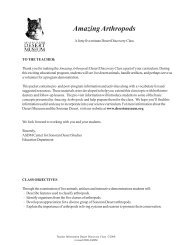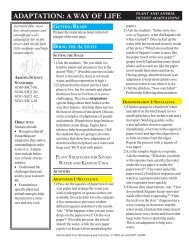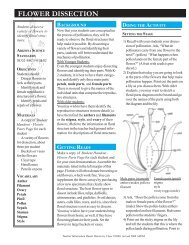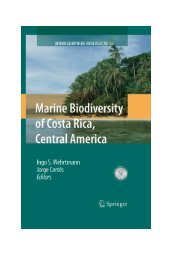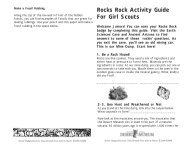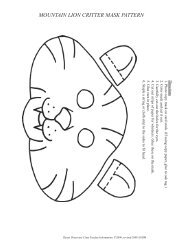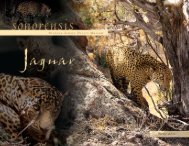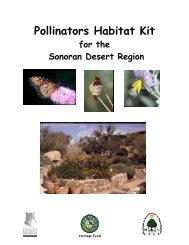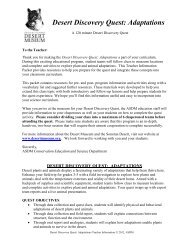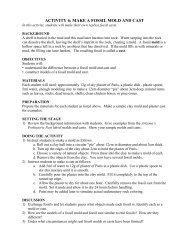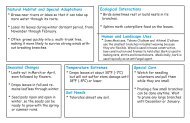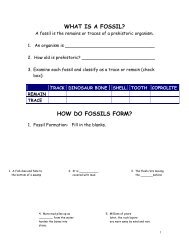A WALK IN THE DESERT - Arizona-Sonora Desert Museum
A WALK IN THE DESERT - Arizona-Sonora Desert Museum
A WALK IN THE DESERT - Arizona-Sonora Desert Museum
You also want an ePaper? Increase the reach of your titles
YUMPU automatically turns print PDFs into web optimized ePapers that Google loves.
A <strong>WALK</strong> <strong>IN</strong> <strong>THE</strong><br />
<strong>DESERT</strong><br />
TEACHER IDEA PACKET<br />
<strong>DESERT</strong> TREK OUTREACH PROGRAM<br />
FOR K<strong>IN</strong>DERGARTEN<br />
Presented by the<br />
<strong>Desert</strong> Trek Outreach Program Supplemental Activities ©2000 ASDM
TABLE OF CONTENTS<br />
<strong>IN</strong>TRODUCTION<br />
Page<br />
To the Teacher .......................................................................................................................... 1<br />
Class Objectives ....................................................................................................................... 1<br />
<strong>Arizona</strong> Academic Standards in Science Correlation .............................................................. 1<br />
Resources ................................................................................................................................. 2<br />
Vocabulary ................................................................................................................................ 2<br />
Activity Overview .................................................................................................................... 3<br />
A Look at The <strong>Sonora</strong>n <strong>Desert</strong>: Background Information for Teachers................................... 3<br />
PRE-PROGRAM ACTIVITIES<br />
1. Animal Adaptations to the <strong>Desert</strong> ............................................................................. 5<br />
Student Handout - Animal Adaptations to the <strong>Desert</strong> ............................................... 7<br />
2. What’s in a Habitat ................................................................................................... 8<br />
Student Handout - Who’s At Home .......................................................................... 9<br />
POST-PROGRAM ACTIVITIES<br />
3. <strong>Desert</strong> Illustration ....................................................................................................... 3<br />
4. <strong>Sonora</strong>n <strong>Desert</strong> Puppets and Masks .......................................................................... 3<br />
Mountain Lion Critter Mask Pattern ........................................................................ 10<br />
Screech Owl and Scorpion Finger Puppet Patterns.................................................. 11<br />
5. <strong>Sonora</strong>n <strong>Desert</strong> ABC’s ............................................................................................... 12<br />
6. In the Shade of the Saguaro ........................................................................................ 13<br />
<strong>Desert</strong> Trek Outreach Program Supplemental Activities ©2000 ASDM
A Walk in the <strong>Desert</strong><br />
A forty five minute science program<br />
for students in kindergarten<br />
To the Teacher:<br />
Thank you for making the A Walk in the <strong>Desert</strong> Outreach Program a part of your curriculum. During<br />
this exciting interactive educational program, students will meet some live <strong>Sonora</strong>n <strong>Desert</strong> animals!<br />
Please be sure to review the enclosed <strong>Desert</strong> Trek Outreach Program Confirmation sheet for<br />
instructions on preparing your room and students for this program.<br />
This packet contains pre- and post- program information and activities along with a vocabulary list and<br />
suggested resources. These materials were developed to help you extend this class topic with both<br />
introductory and follow-up lessons. The pre-visit information will introduce students to some of the<br />
basic concepts presented in A Walk in the <strong>Desert</strong> and help prepare them for the program. We hope<br />
you’ll find this information useful and easy to incorporate into your science curriculum. For more<br />
information about the <strong>Desert</strong> <strong>Museum</strong> and the <strong>Sonora</strong>n <strong>Desert</strong>, visit our website at<br />
www.desertmuseum.org.<br />
We welcome and value your comments and suggestions concerning this program and the corresponding<br />
Teacher Idea Packet. At the end of the program, we will give you an evaluation form and would appreciate<br />
your taking the time to complete it within a week and mail it back to us. If you develop lessons or<br />
activities related to this topic that work well with your students, we would appreciate your sending us a<br />
copy. We will give you credit for any materials we use.<br />
We look forward to working with you and your students at your school.<br />
Sincerely,<br />
ASDM Education Department<br />
CLASS OBJECTIVES<br />
Through the examination of live animals, artifacts and interactive demonstrations students will:<br />
• Develop an understanding of the physical characteristics of a desert.<br />
• Identify some common <strong>Sonora</strong>n <strong>Desert</strong> plants and animals.<br />
• Determine the adaptations of specific desert plants and animals that enable them to live in the<br />
<strong>Sonora</strong>n <strong>Desert</strong> environment.<br />
• Develop an appreciation for our desert and the creatures that inhabit it.<br />
• Determine measures they can take to help conserve our desert ecosystem.<br />
ARIZONA ACADEMIC STANDARDS <strong>IN</strong> SCIENCE CORRELATION:<br />
<strong>Desert</strong> Trek Outreach Program: 1SC-R3, 4SC-R3, 4SC-F4<br />
Pre- and Post-Program Activities: 1SC-R2, 1SC-R3, 4SC-R2, 4SC-R3, 4SC-F4<br />
1<br />
<strong>Desert</strong> Trek Outreach Program Supplemental Activities ©2000 ASDM
RESOURCES<br />
<strong>Arizona</strong>-<strong>Sonora</strong> <strong>Desert</strong> <strong>Museum</strong> Press: (publications for adults)<br />
These may be ordered directly through our website (www.desertmuseum.org) or by contacting the<br />
ASDM publications manager at 883-3028.<br />
• <strong>Arizona</strong>-<strong>Sonora</strong> <strong>Desert</strong> <strong>Museum</strong>: A Natural History of the <strong>Sonora</strong>n <strong>Desert</strong>. Tucson: ASDM<br />
Press, 1999.<br />
• Friederici, Peter. Strangers in our Midst, The Startling World of <strong>Sonora</strong>n <strong>Desert</strong> Arthropods.<br />
Tucson: ASDM Press, 1996<br />
• Hanson, Jonathan and Roseann Beggy Hanson. <strong>Desert</strong> Dogs: Coyotes, Foxes, and Wolves.<br />
Tucson: ASDM Press, 1995.<br />
• Lazaroff, David. <strong>Arizona</strong>-<strong>Sonora</strong> <strong>Desert</strong> <strong>Museum</strong> Book of Answers. Tucson: ASDM Press, 1998.<br />
• Lazaroff, David. The Secret Lives of Hummingbirds. Tucson: ASDM Press, 1995.<br />
• Merlin, Pinau. A Field Guide to <strong>Desert</strong> Holes. Tucson: ASDM Press, 1999.<br />
Children’s Books:<br />
• Albert, Richard E.: Alejandro’s Gift. San Francisco, Chronicle Books, 1994.<br />
• Cobb, Vicki. This Place Is Dry. New York: Walker, 1989.<br />
• Skramstad. Wildlife Southwest. San Francisco: Chronicle Books, 1992.<br />
• Urquhart, Jennifer C. and Barbara Gibson. Creatures of the <strong>Desert</strong> World. Washington, D.C.:<br />
National Geographic Society, 1987.<br />
• Wiewandt, Thomas. The Hidden Life of the <strong>Desert</strong>. New York: Crown Publishers, 1990.<br />
• Zoehfeld, Kathleen Weidner. Cactus Café. A Story of the <strong>Sonora</strong>n <strong>Desert</strong>. Norwalk, Ct:<br />
Soundprints, 1997.<br />
Activity Book:<br />
• Braus, J., ed. Ranger Rick’s Nature Scope: Discovering <strong>Desert</strong>s. Washington D.C.: National<br />
Wildlife Federation, 1985. (For ordering information call:1-800-722-4726)<br />
Organizations:<br />
• <strong>Arizona</strong>-<strong>Sonora</strong> <strong>Desert</strong> <strong>Museum</strong>: 2021 N. Kinney Rd., Tucson, AZ 85743. Phone: (520) 883-<br />
3025. www.desertmuseum.org<br />
• <strong>Desert</strong> USA: www.desertusa.com/animal.html [This site contains information on many desert<br />
plants and animals, including photos.]<br />
• Tucson Audubon Society: www.audubon.org/chpter/az/tucson<br />
• <strong>Sonora</strong>n Arthropod Studies Institute (SASI): (520) 883-2578<br />
VOCABULARY<br />
Adaptation - Body features or behaviors that help a creature survive in its environment (i.e. an eagle<br />
has sharp talons that help it grab and hold its prey.)<br />
Camouflage - An animal’s color pattern that helps it blend in with its surroundings.<br />
<strong>Desert</strong> - An area low in moisture for most of the year.<br />
Evaporation - Changing from a liquid to a gas.<br />
Habitat - The place in which an animal or plant lives that provides the food, water, shelter, and<br />
space needed for its survival.<br />
Nocturnal - Active at night.<br />
<strong>Desert</strong> Trek Outreach Program Supplemental Activities ©2000 ASDM 2
PRE-PROGRAM <strong>IN</strong>FORMATION AND ACTIVITIES<br />
Teacher Background Information: A LOOK AT <strong>THE</strong> SONORAN <strong>DESERT</strong> (pp. 3-4)<br />
This short reading provides you with some background information on the <strong>Sonora</strong>n <strong>Desert</strong><br />
Region and an introduction to the topic of your outreach program.<br />
Activity 1: ANIMAL ADAPTATIONS TO <strong>THE</strong> <strong>DESERT</strong> (pp. 5-7)<br />
This series of activities introduces students to desert aridity and the process of evaporation. Students<br />
learn how some desert animals are adapted to this dry, often hot, environment.<br />
Activity 2: WHAT’S <strong>IN</strong> A HABITAT (pp.8-9)<br />
Introduce students to the elements of a habitat with a cut-and-paste activity sheet that focuses on<br />
animal homes.<br />
POST-PROGRAM <strong>IN</strong>FORMATION AND ACTIVITIES<br />
Activity 3: <strong>DESERT</strong> ILLUSTRATION<br />
After students participate in A Walk in the <strong>Desert</strong> Outreach Program, have them draw a <strong>Sonora</strong>n<br />
<strong>Desert</strong> scene, complete with some of the animals and plants they just learned about. Students can<br />
also draw, color, and cut out desert plants and animals and glue these on a large sheet of paper to<br />
create a class collage.<br />
Activity 4: SONORAN <strong>DESERT</strong> PUPPETS AND MASKS (pp. 11-12)<br />
Using the enclosed templates, students make finger puppets and masks of desert animals. Discuss<br />
each animal’s adaptations to the desert and for feeding. What does each eat (Scorpions are nocturnal,<br />
feeding on insects and other small arthropods which are killed or subdued by venom injected<br />
through the stinger at the end of the “tail.” The screech owl is nocturnal and eats insects and other<br />
invertebrates along with small mammals, such as mice. Mountain lions are predators, living in the<br />
mountain regions of the <strong>Sonora</strong>n <strong>Desert</strong>, eating primarily deer and other mammals.)<br />
Activity 5: SONORAN <strong>DESERT</strong> ABC’S (p. 13)<br />
Students create alphabet cards that depict life in the <strong>Sonora</strong>n <strong>Desert</strong>.<br />
Activity 6: <strong>IN</strong> <strong>THE</strong> SHADE OF <strong>THE</strong> SAGUARO (pp. 14-15)<br />
Students learn a song about common <strong>Sonora</strong>n <strong>Desert</strong> animals.<br />
A LOOK AT <strong>THE</strong> SONORAN <strong>DESERT</strong><br />
Background Information for Teachers<br />
The <strong>Arizona</strong>-<strong>Sonora</strong><br />
<strong>Desert</strong> <strong>Museum</strong> is located<br />
in the <strong>Sonora</strong>n <strong>Desert</strong>.<br />
This desert is one of four<br />
that occur in North<br />
America. The other three<br />
are the Great Basin,<br />
Mojave and Chihuahuan<br />
deserts. <strong>Arizona</strong> is the<br />
only state in which all four<br />
deserts can be found.<br />
3<br />
<strong>Desert</strong> Trek Outreach Program Supplemental Activities ©2000 ASDM
What Is A <strong>Desert</strong><br />
All deserts share a common factor – they are dry! Little rain falls in the desert, often less than 10<br />
inches per year. The rain that does fall may come in sudden large bursts from a violent desert thunderstorm.<br />
Much of this water runs off the soil into washes or evaporates before it has a chance to<br />
soak into the ground. This leaves little water for plants and animals.<br />
Other characteristics of deserts include windy conditions, intense sunlight, unpredictable and changing<br />
amounts of annual rainfall, and great differences between day and night temperatures (days may<br />
be hot, but nights may be much cooler).<br />
The <strong>Sonora</strong>n <strong>Desert</strong><br />
The <strong>Sonora</strong>n <strong>Desert</strong>, for the most part, is a low,<br />
hot desert. Parts of this desert get less than 3<br />
inches of rain a year! Winters are mild and<br />
summers are hot. Summertime temperatures may<br />
reach 120°F. Tucson and the area surrounding the<br />
<strong>Arizona</strong>-<strong>Sonora</strong> <strong>Desert</strong> <strong>Museum</strong> get an average of<br />
11.4 inches of precipitation per year. Rainy<br />
seasons vary throughout the desert, but in our<br />
area, the rainy seasons usually come twice a year,<br />
in the late summer and winter.<br />
The <strong>Sonora</strong>n <strong>Desert</strong> is quite lush when compared<br />
to other deserts of the world. It contains over<br />
2,000 different species of flowering plants alone.<br />
Columnar cacti (such as saguaro and organ pipe)<br />
and legume trees (such as mesquite, palo verde,<br />
acacia) visually dominate the landscape.<br />
The <strong>Arizona</strong>-<strong>Sonora</strong> <strong>Desert</strong> <strong>Museum</strong> is an excellent<br />
place to visit to learn more about the natural<br />
history of this fascinating region. The <strong>Desert</strong><br />
<strong>Museum</strong> displays only the plants and animals of<br />
the <strong>Sonora</strong>n <strong>Desert</strong> Region. This region includes<br />
the desert itself and the non-desert communities<br />
found next to – or within — the desert. These<br />
other communities include riparian corridors<br />
(lush areas along streams), pine-topped mountain<br />
islands, and desert grasslands.<br />
<strong>Desert</strong> Plants and Animals<br />
There are many differetn kinds of plants and animals in the <strong>Sonora</strong>n <strong>Desert</strong>. Life thrives here because<br />
organisms are adapted to this environment. They have ways of surviving the lack of water and hot<br />
summer days. Many are so well adapted to the desert that they could not survive anywhere else!<br />
In this outreach program, students will learn about climatic stresses of the desert environment, then<br />
take an imaginary “walk” in the desert to discover the adaptations of some common plants and<br />
animals we meet along the way.<br />
<strong>Desert</strong> Trek Outreach Program Supplemental Activities ©2000 ASDM<br />
4
1. ANIMAL ADAPTATIONS TO <strong>THE</strong> <strong>DESERT</strong><br />
Students perform<br />
experiments and<br />
activities to understand<br />
<strong>Sonora</strong>n <strong>Desert</strong><br />
animals’ adaptations<br />
to their environment.<br />
ARIZONA SCIENCE<br />
STANDARDS<br />
4SC-F4, 1SC-R2<br />
OBJECTIVES<br />
Students should:<br />
• Identify adaptations<br />
of animals that<br />
allow them to live in<br />
specific environments.<br />
• Formulate questions<br />
about objects,<br />
organisms, events and<br />
relationships in the<br />
natural world.<br />
MATERIALS<br />
• Copy of Student<br />
Handout - Animal<br />
Adaptations to the<br />
<strong>Desert</strong> for each<br />
student<br />
• Buckets of water<br />
• Paper towels<br />
• Chalkboard<br />
• Markers or crayons<br />
VOCABULARY<br />
Adaptation<br />
Evaporation<br />
BACKGROUND<br />
Organisms adapt to their environment.<br />
<strong>Desert</strong> environments pose interesting<br />
challenges for survival, and desert<br />
animals have developed unique adaptations<br />
for living here.<br />
SETT<strong>IN</strong>G <strong>THE</strong> STAGE<br />
1) Dip a paper towel in a bucket of<br />
water and wring the excess water into<br />
the bucket. Take the moistened paper<br />
towel and wipe it across the chalkboard.<br />
Watch the moisture begin to<br />
disappear. Ask the students, “What<br />
happened to the water” (It evaporated<br />
into the air.) Explain that here in<br />
the desert, it is hot and dry, and water<br />
disappears or evaporates into the air<br />
all the time.<br />
2) Ask the students, “What kinds of<br />
things does water evaporate from”<br />
(clothes on a line, puddles, pavement,<br />
etc.) If they don’t think of it, ask the<br />
students, “Does water evaporate from<br />
plants and animals, too” (yes)<br />
3) Ask, “Do you think it is hard for<br />
living things to live in the desert<br />
where there is not much water and it<br />
evaporates away” (yes) “How do<br />
they survive” (They should generate<br />
examples of how animals/plants are<br />
able to survive in the desert.)<br />
4) Explain that these are examples of<br />
adaptations – body parts or actions –<br />
that help animals and plants live here.<br />
Tell them you will be going outside to<br />
do a series of activities to demonstrate<br />
adaptations that desert animals have<br />
to help them live in the desert.<br />
ADAPTATION ACTIVITIES<br />
ADAPTATION 1: REST<strong>IN</strong>G <strong>IN</strong> SHADE<br />
OR <strong>IN</strong> A BURROW, ACTIVE AT NIGHT<br />
1) Bring the buckets of water and paper<br />
towels outside. Find a spot where<br />
pavement is in sunshine and in shade.<br />
2) Have the students dampen and ball<br />
up a paper towel and write their<br />
initials on the pavement on both the<br />
sunny side and shady side. Ask them<br />
to closely observe which one dries up<br />
more quickly. (the one in direct<br />
sunshine) Ask, “What does this tell<br />
you about the sunny side” (that water<br />
dries up more quickly in the sun)<br />
“Which side feels hotter” (the sunny<br />
side)<br />
3) Ask, “If you were an animal living<br />
out in the desert, what might you do<br />
to keep cool and try not to lose much<br />
water” (rest in the shade at the<br />
hottest times of day, come out when it<br />
is cooler)<br />
4) Explain that many desert animals are<br />
active either at night or in the cooler<br />
hours of the day. They pass the heat of<br />
the day resting in deep shade or down<br />
in burrows out of the sun.<br />
ADAPTATION 2: PANT<strong>IN</strong>G<br />
OR SWEAT<strong>IN</strong>G<br />
1) Ask the children: “What happens to<br />
us when we get hot and our body tries<br />
to cool us down” (We sweat.) “How<br />
does sweating cool us off” (Our<br />
sweat evaporates and cools us.)<br />
2) To illustrate this, have the students<br />
roll up their sleeves and dip one arm<br />
in the bucket of water, leaving the<br />
other arm dry. Have them wave both<br />
arms in the air. Ask: “Which arm is<br />
cooler Why” (Evaporation on the<br />
5<br />
<strong>Desert</strong> Trek Outreach Program Supplemental Activities ©2000 ASDM
1. ANIMAL ADAPTATIONS TO <strong>THE</strong> <strong>DESERT</strong><br />
ANSWER KEY TO<br />
<strong>THE</strong> <strong>DESERT</strong> ADAP-<br />
TATIONS HANDOUT<br />
There are six adaptations,<br />
covered in the<br />
activities and discussion<br />
above, depicted<br />
in the handout.<br />
• a fox in its den in<br />
the heat of the day<br />
a javelina resting in<br />
the shade beneath a<br />
tree<br />
• a kangaroo rat<br />
active at night<br />
• a bird panting<br />
• a desert tortoise<br />
resting in its burrow<br />
and storing water in its<br />
bladder<br />
• a jackrabbit sitting<br />
in the shade and<br />
cooling its blood<br />
through its big ears<br />
The black bear does<br />
not belong in the<br />
picture.<br />
wet arm cools the air down around<br />
the arm, making it feel cooler.) “Do<br />
you think very many desert animals<br />
sweat” (no) Why” (Possible<br />
answer: few desert animals sweat<br />
because there is so little water to<br />
drink to replace the water lost.)<br />
3) But there are other ways to keep<br />
cool. Ask, “What do dogs do to keep<br />
cool” (pant) Explain that when they<br />
pant, dogs’ blood is cooled as it<br />
passes through their tongue because<br />
water evaporates from dogs’ tongues<br />
and cools them down. Coyotes,<br />
mountain lions, birds, and many<br />
other desert animals pant to cool<br />
down.<br />
DISCUSSION<br />
1) Return to the classroom. Pass out<br />
Student Handout - Animal Adaptations<br />
to the <strong>Desert</strong> to each student.<br />
Point out that part of the picture<br />
represents daytime, the other part<br />
night. Ask the children to look at the<br />
picture and describe the adaptations<br />
they see that animals have to save<br />
water and keep cool. (They should<br />
notice those already discussed – a<br />
fox in its den in the heat of the day, a<br />
javelina resting in the shade beneath<br />
a tree, a bird panting, a kangaroo rat<br />
active at night. Have them circle<br />
these.)<br />
2) Ask, “Can you see any other animal<br />
adaptations for life in the desert in<br />
this picture” (The desert tortoise<br />
and jackrabbit are both resting in the<br />
shade. These animals have other<br />
desert adaptations as well. <strong>Desert</strong><br />
tortoises store water in their bladders<br />
and can go a long time without<br />
drinking, but when it is hot they<br />
retreat to their burrows. Jackrabbits<br />
rest in the shade and use their big<br />
ears to cool down their blood. Their<br />
warm blood circulates into their ears<br />
and is cooled when exposed to the<br />
cooler air.) Point out these animals in<br />
the picture, explaining their adaptations.<br />
Have the children circle them.<br />
3)Then ask, “Which animal does not<br />
seem adapted to the desert” (The<br />
black bear.) “Why” (It has thick hair<br />
and is out in the sunshine in the<br />
middle of the day.) Have them put an<br />
X over the bear.<br />
4)Have the students color the picture.<br />
Remind them to distinguish between<br />
day and night.<br />
EXTENSION<br />
CREATE A <strong>DESERT</strong> CREATURE!<br />
The students can create and draw their<br />
own animal or plant with its own<br />
adaptations for desert survival. Have<br />
them share their creations with each<br />
other to see if others can figure out the<br />
creatures’ adaptations.<br />
<strong>Desert</strong> Trek Outreach Program Supplemental Activities ©2000 ASDM 6
NAME_____________________________________<br />
STUDENT HANDOUT<br />
ANIMAL ADAPTATIONS TO <strong>THE</strong> <strong>DESERT</strong><br />
7<br />
<strong>Desert</strong> Trek Outreach Program Supplemental Activities ©2000 ASDM
2. WHAT’S <strong>IN</strong> A HABITAT<br />
Introduces the elements<br />
of habitat with a cutand-paste<br />
worksheet<br />
that focuses on animal<br />
homes.<br />
ARIZONA SCIENCE<br />
STANDARDS<br />
1SC-R2, 1SC-R3,<br />
4SC-R2<br />
OBJECTIVES<br />
Students should:<br />
• List the elements<br />
of a habitat (food,<br />
water, shelter,<br />
space.)<br />
• Understand that<br />
the amount and<br />
availability of these<br />
elements can change<br />
over time.<br />
MATERIALS<br />
• Student Handout -<br />
Who’s at Home for<br />
each student<br />
• scissors<br />
• glue<br />
• markers<br />
• crayons<br />
VOCABULARY<br />
Habitat<br />
GETT<strong>IN</strong>G READY<br />
Make a copy of Student Handout -<br />
Who’s at Home for each student.<br />
DO<strong>IN</strong>G <strong>THE</strong> ACTIVITY<br />
SETT<strong>IN</strong>G <strong>THE</strong> STAGE<br />
1) Present the idea of habitat by asking<br />
the students “What do you need to<br />
live” Without much prompting, they<br />
should all list examples of foods they<br />
eat and the fact that they all drink<br />
water.<br />
2) The other elements of habitat, shelter<br />
and space, may be less obvious. Ask<br />
the students, “In what sort of place do<br />
each of you live” (a house, apartment,<br />
etc.) “Why do you live in these<br />
places” (for protection from cold,<br />
heat, rain, or sun, or danger.) Explain<br />
that many living things take shelter in<br />
some way. Some make it, some find it,<br />
and some develop body parts to protect<br />
themselves. Ask the students, “Can<br />
you think of an animal that builds a<br />
shelter or home for itself or its babies”<br />
(a bird, a mouse, etc)<br />
3) Ask one of the students, “How many<br />
rooms does your house/apartment<br />
have Do you think it would be okay if<br />
all of us came and moved in there with<br />
you Why not” (No. It would be too<br />
crowded.) Explain that just like we all<br />
have separate houses (or shelter)<br />
around town and do not share them<br />
with the whole class, all living things<br />
need the space to make their homes<br />
and find the food and water they need<br />
to live.<br />
4) Explain that these are the things that<br />
make up a habitat: the area where an<br />
animal or plant lives and finds the<br />
food, water, shelter, and space it needs<br />
for survival.<br />
ACTIVITY: WHO’S AT HOME<br />
1) Give the students a copy of Student<br />
Handout - Who’s at Home and<br />
instruct them to color the desert<br />
scene with its animal homes and<br />
each animal.<br />
2) Have them cut out the different<br />
animals and paste them in the correct<br />
homes.<br />
WHO’S AT HOME (ANSWERS)<br />
See the corresponding names of homes<br />
on the handout.<br />
1) <strong>Desert</strong> Tortoise (underground<br />
burrow in rocky outcropping)<br />
2) Javelina (bed in the shade beneath<br />
palo verde tree)<br />
3) Pack Rat (nest under prickly pear at<br />
foot of saguaro, tunnels underground)<br />
4) Elf Owl (cavity nest in saguaro)<br />
DISCUSSION<br />
Discuss the homes of the different<br />
animals in the pictures as a group.<br />
Where do the animals make their<br />
homes What might be the advantages<br />
or disadvantages of certain types of<br />
homes<br />
<strong>Desert</strong> Trek Outreach Program Supplemental Activities ©2000 ASDM<br />
8
NAME_____________________________________<br />
STUDENT HANDOUT - WHO’S AT HOME<br />
Color the animals and the picture of their homes.<br />
Cut out the animals along the dotted lines. Glue<br />
the animal in the circle of its home.<br />
cavity nest<br />
bed<br />
nest<br />
burrow<br />
tortoise<br />
javelina<br />
pack rat<br />
elf owl<br />
9<br />
<strong>Desert</strong> Trek Outreach Program Supplemental Activities ©2000 ASDM
MOUNTA<strong>IN</strong> LION CRITTER MASK PATTERN<br />
Directions<br />
1. Photo copy mask on card stock. (If using copy paper, glue to oak tag.)<br />
2. Color mask and cut it out.<br />
3. Carefully cut out the holes for the eyes.<br />
4. Cut out strips of paper for whiskers. Glue these on the mask.<br />
5. Glue ears in place.<br />
6. Staple a string or cloth strip to the sides to fit head.<br />
<strong>Desert</strong> Trek Outreach Program Supplemental Activities ©2000 ASDM<br />
10
SCREECH OWL F<strong>IN</strong>GER PUPPET PATTERN<br />
SCORPION F<strong>IN</strong>GER PUPPET PATTERN<br />
Directions<br />
1. Color each puppet and cut it out.<br />
2. Punch out holes and insert pipe<br />
cleaners.<br />
3. Wrap pipe cleaner around finger.<br />
11<br />
<strong>Desert</strong> Trek Outreach Program Supplemental Activities ©2000 ASDM
5. SONORAN <strong>DESERT</strong> ABC’S<br />
Students create alphabet<br />
cards that depict<br />
life in the <strong>Sonora</strong>n<br />
<strong>Desert</strong> Region.<br />
ARIZONA SCIENCE<br />
STANDARDS<br />
1SC-R3<br />
OBJECTIVES<br />
Students should:<br />
• Demonstrate<br />
knowledge of many<br />
of the animals and<br />
plants they have<br />
studied in the outreach<br />
program and<br />
supplemental activities.<br />
• Create card<br />
games to share with<br />
each other and other<br />
classes.<br />
MATERIALS<br />
• blackboard<br />
• 3 x 5 index cards,<br />
blank (3 or more for<br />
each student)<br />
• sample alphabet<br />
cards, made by<br />
teacher before the<br />
activity<br />
• construction paper<br />
• scrap paper<br />
• pencils<br />
• markers<br />
• crayons<br />
• paints<br />
• scissors<br />
• masking tape<br />
GETT<strong>IN</strong>G READY<br />
Prepare the materials as listed in the<br />
materials column on the left of this page.<br />
Color your sample alphabet cards ahead of<br />
time, or create your own during class.<br />
DO<strong>IN</strong>G <strong>THE</strong> ACTIVITY<br />
SETT<strong>IN</strong>G <strong>THE</strong> STAGE<br />
Through the previous activities and the<br />
outreach program, your students should<br />
have a large repertoire of words which<br />
represent the plants, animals, and life<br />
zones of the <strong>Sonora</strong>n <strong>Desert</strong> Region. This<br />
activity lets you review what they have<br />
seen and learned.<br />
1) Ask the students “What plants and<br />
animals did the teachers from the <strong>Desert</strong><br />
<strong>Museum</strong> talk about and show us” List<br />
their observations on the blackboard.<br />
Have them brainstorm a list of everything<br />
they can think of that they might<br />
find in the <strong>Sonora</strong>n <strong>Desert</strong> Region. Tell<br />
your students that the class is going to<br />
make alphabet cards based on all the<br />
exciting discoveries they have made.<br />
2) Organize their words alphabetically, and<br />
try to come up with something for each<br />
letter. For example, A= agave B= bat,<br />
boojum C= cactus wren, coyote D=<br />
dust, dinosaur bones and so on.<br />
MAK<strong>IN</strong>G CARDS<br />
1) Show the students the sample cards you<br />
made and have them select some of the<br />
items on the class list to make into their<br />
own alphabet cards. Encourage them to<br />
be creative and not limit themselves to<br />
your examples.<br />
2) Have the students draw the picture of<br />
their plant or animal on the card and<br />
color it, then write the first letter of the<br />
animal or plant on the top of the card.<br />
CARD GAMES<br />
1) When they finish, ask them to write<br />
their names on the back of their<br />
cards.<br />
2) In small groups or as a whole class,<br />
create patterns with the cards. Lay<br />
out the example cards and students’<br />
cards in patterns so the cards:<br />
• spell out a name of something<br />
in the <strong>Sonora</strong>n <strong>Desert</strong><br />
• list the entire alphabet<br />
• depict categories that represent<br />
things found in the desert such<br />
as plants, animals, geologic<br />
features, minerals, native<br />
foods, etc.<br />
3) You can arrange them on tables or<br />
tape them to a bulletin board or<br />
chalk board in order. Other ideas for<br />
ways to use the cards include:<br />
• create a new card game<br />
• collect and trade cards with<br />
other participants or other<br />
classes<br />
• create a collage that represents<br />
a story of the <strong>Sonora</strong>n <strong>Desert</strong><br />
<strong>Desert</strong> Trek Outreach Program Supplemental Activities ©2000 ASDM 12
6. <strong>IN</strong> <strong>THE</strong> SHADE OF <strong>THE</strong> SAGUARO<br />
“In the Shade of the Saguaro” is one of the many <strong>Sonora</strong>n <strong>Desert</strong> songs for kids written by Patty Horn, a<br />
Tucson songwriter and musician. Patty has produced 3 tapes/CD’s and song books with a wonderful<br />
variety of songs about animals, plants, and people of the <strong>Sonora</strong>n <strong>Desert</strong>. Patty’s songs are a great way to<br />
entertain and teach about the <strong>Sonora</strong>n <strong>Desert</strong>. Her CD’s include vocal tracks and backing (instrumental<br />
only) tracks. For a complete listing of tapes, CD’s, songbooks, and how to order, look at the website:<br />
http://www.pattyhorn.com, or write/call the following: e-mail, music@pattyhorn.com, phone (1-888-219-<br />
1735), fax (1-520-577-8006), or mail: Two Geckos Music & Publishing, PO Box 30274, Tucson, AZ<br />
85751.<br />
13<br />
<strong>Desert</strong> Trek Outreach Program Supplemental Activities ©2000 ASDM
<strong>Desert</strong> Trek Outreach Program Supplemental Activities ©2000 ASDM 14



